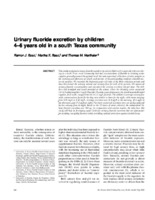Urinary fluoride excretion by children 4-6 years old in a south Texas community
| dc.contributor.author | Baez, Ramon J | es_ES |
| dc.contributor.author | Baez, Martha X | es_ES |
| dc.contributor.author | Marthaler, Thomas M | es_ES |
| dc.date.accessioned | 2015 | |
| dc.date.available | 2015 | |
| dc.date.issued | 2000 | es_ES |
| dc.identifier.citation | Baez, Ramon J,Baez, Martha X,Marthaler, Thomas M (2000) Urinary fluoride excretion by children 4-6 years old in a south Texas community. Rev Panam Salud Publica;7(4) -,abr. 2000. Retrieved from http://www.scielosp.org/scielo.php?script=sci_arttext&pid=S1020-49892000000400005&lng=pt&nrm=iso | es_ES |
| dc.identifier.uri | http://www.scielosp.org/scielo.php?script=sci_arttext&pid=S1020-49892000000400005&lng=pt&nrm=iso | es_ES |
| dc.identifier.uri | https://iris.paho.org/handle/10665.2/8831 | |
| dc.format.extent | tab | es_ES |
| dc.relation.ispartofseries | Rev Panam Salud Publica;7(4),abr. 2000 | es_ES |
| dc.subject | Urina | es_ES |
| dc.subject | Fluoretos | es_ES |
| dc.subject | Água Potável | pt_BR |
| dc.subject | Estados Unidos | es_ES |
| dc.title | Urinary fluoride excretion by children 4-6 years old in a south Texas community | es_ES |
| dc.type | Journal articles | en_US |
| dc.rights.holder | Pan American Health Organization | en_US |
| dc.description.notes | This study evaluated urinary fluoride excretion by school children 4-6 years old who were living in a south Texas rural community that had concentrations of fluoride in drinking water supplies generally around the optimal level. We took supervised collections of urine samples in the morning and afternoon at school, and parents of the participating students collected nocturnal samples. We recorded the beginning and end times of the three collection periods and then determined the urinary volume and urinary flow for each of the periods. We measured urinary fluoride concentrations and calculated the urinary excretion rate per hour. The children had breakfast and lunch provided at the school, where the drinking water contained 1.0-1.3 milligrams/liter (mg/L) fluoride. Fluoride concentrations in the tested household water supplies, from wells, ranged from 0.1 to 3.2 mg/L fluoride. The children's average urinary fluoride concentrations found for the day were similar to those for the night, with means ranging from 1.26 mg/L to 1.42 mg/L. Average excretion was 36.4 mg/h in the morning, 45.6 mg/h in the afternoon, and 17.5 mg/h at night. The lower nocturnal excretion rates are easily explained by low urinary flow at night. Based on the 15 hours of urine collected, the extrapolated 24-hour fluoride excretion was 749 µg. In conjunction with similar studies, the data from this study will help in developing upper limits for urinary fluoride excretion that are appropriate for avoiding unsightly fluorosis while providing optimal protection against dental decay | en_US |
Files in this item
This item appears in the following Collection(s)
-
Pan American Journal of Public Health
Revista Panamericana de Salud Pública

